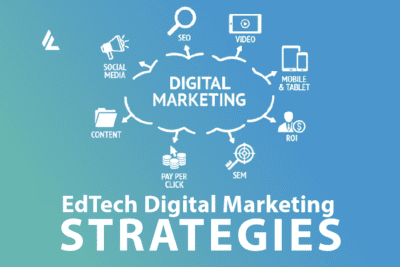Have you considered creating private communities to engage with potential customers as an edtech company? Private communities are becoming increasingly popular in edtech marketing, and for good reason. By creating a private community, you can foster a sense of belonging and support among your target audience, which can lead to increased brand loyalty and customer retention.

Private communities can take many forms, from online forums to social media groups to exclusive events. The key is to create a space where your target audience can connect with each other and with your brand. By providing value through educational resources, networking opportunities, and exclusive content, you can establish yourself as a thought leader in the edtech space and build trust with potential customers.
In addition to building brand loyalty and trust, private communities can also provide valuable insights into your target audience. By monitoring discussions and engagement within your community, you can gain a better understanding of your customers’ needs and preferences. This can inform your marketing strategy and help you create more targeted and effective campaigns.
The Role of Private Communities in Edtech Marketing
Private communities, which are typically closed to the public, provide a space for educators, students, and other stakeholders to engage with each other and with the brand. This section explores the role of private communities in edtech marketing and how they can be used to build trust and engagement, as well as leverage content marketing and SEO.
Building Trust and Engagement
One of the key benefits of private communities is that they allow for more personalized and direct communication between the brand and its audience. By creating a space where educators and students can interact with each other and with the brand, private communities can help build trust and engagement. When educators and students feel that their voices are being heard and that they are part of a community, they are more likely to be loyal to the brand and recommend it to others.

Private communities can also be used to provide exclusive content and resources to members. This can include webinars, white papers, and other educational materials that are not available to the public. By providing valuable resources to members, the brand can demonstrate its expertise and commitment to education, further building trust and engagement.
Leveraging Content Marketing and SEO
Private communities can also be a valuable tool for content marketing and SEO. By creating a space where educators and students can share their experiences and insights, the brand can gather valuable data and feedback that can be used to inform content creation. This can help ensure that the brand’s content is relevant and valuable to its audience, which can improve engagement and lead to higher search engine rankings.
Private communities can also be used to promote content and drive traffic to the brand’s website. By sharing links to blog posts, videos, and other content within the community, the brand can encourage members to visit its website and engage with its content. This can help improve the brand’s search engine rankings and increase its visibility online.
Therefore, private communities can play a valuable role in edtech marketing by building trust and engagement, as well as leveraging content marketing and SEO. By creating a space where educators and students can interact with each other and with the brand, private communities can help foster a sense of community and loyalty, while also providing valuable data and feedback that can inform content creation and improve search engine rankings.
Strategies for Developing Effective Edtech Marketing

When it comes to developing effective marketing strategies for your edtech business, there are several factors to consider. Let us discuss some of the key strategies that can help you reach your target audience, incorporate data-driven insights, and utilize digital marketing and social media to drive growth.
Understanding Your Target Audience
One of the most important aspects of developing an effective edtech marketing strategy is understanding your target audience. This means taking the time to research and analyze the needs, interests, and behaviors of your ideal customers. By doing so, you can tailor your messaging and marketing efforts to better resonate with your target audience.
You can use a variety of tools and techniques to better understand your target audience, such as:
- Conducting surveys and focus groups to gather feedback and insights from your customers
- Analyzing data from your website, social media, and other digital channels to identify trends and patterns
- Creating buyer personas to help you visualize and understand the different segments of your target audience
Incorporating Data-Driven Insights
In addition to understanding your target audience, it’s important to incorporate data-driven insights into your marketing strategy. This means using data and analytics to inform your decision-making and optimize your marketing efforts.
Some key data-driven insights to consider include:
- Website traffic and engagement metrics, such as bounce rate, time on page, and click-through rates
- Social media engagement metrics, such as likes, shares, and comments
- Conversion metrics, such as lead generation and sales
Analyzing these metrics and using them to inform your marketing decisions can help you optimize your campaigns for maximum impact and ROI.

Utilizing Digital Marketing and Social Media
Finally, it’s important to leverage digital marketing and social media to reach your target audience and drive growth. This means using a variety of channels and tactics to promote your brand, engage with your audience, and drive conversions.
Some key digital marketing and social media tactics to consider include:
- Search engine optimization (SEO) to improve your website’s visibility and search rankings
- Pay-per-click (PPC) advertising to drive targeted traffic to your website and landing pages
- Social media marketing to engage with your audience and promote your brand
- Email marketing to nurture leads and promote your products and services
By utilizing these tactics and channels effectively, you can develop a comprehensive EdTech marketing strategy that reaches your target audience and drives growth for your business.
Challenges and Opportunities in Creating Private Communities
Marketing in the edtech industry can be a challenging task, but there are also plenty of opportunities to capitalize on. Success in this domain requires you to be aware of the challenges and trends in the industry and be able to navigate them effectively.
Navigating Competition and Privacy Concerns
One of the biggest challenges in edtech marketing is competition. There are numerous companies vying for the attention of educators and students, making it difficult to stand out from the crowd. Overcome this challenge requires a clear understanding of your target audience and what sets your product apart from the competition.

Another challenge in edtech private communities marketing is privacy concerns. With the increasing amount of data being collected by EdTech companies, privacy has become a major concern for educators and parents. To address this concern, you need to be transparent about your data collection practices and ensure that you are complying with all relevant regulations.
Capitalizing on EdTech Trends and Innovations
Success in edtech marketing is also anchored on the latest trends and innovations in the industry. One trend that has been gaining traction in recent years is the use of private communities. Private communities allow educators and students to collaborate and share resources in a secure environment. Capitalizing on this trend help help you provide a unique value proposition to your target audience.
Another trend to watch out for is the increasing use of artificial intelligence (AI) and machine learning in edtech. These technologies can be used to personalize learning experiences and provide more targeted recommendations to students. By incorporating AI and machine learning into your product, you can stay ahead of the competition and provide a more engaging experience for your users.
While edtech marketing can be challenging, there are plenty of opportunities to succeed if you stay up-to-date with the latest trends and innovations, navigate competition and privacy concerns effectively, and provide a unique value proposition to your target audience. By following these strategies, you can increase your chances of marketing success in the EdTech industry.
Measuring the Success of Private Communities Marketing
When it comes to measuring the success of your edtech marketing campaigns, there are several key metrics that you should be tracking. You can gain valuable insights into the effectiveness of your marketing efforts and make data-driven decisions to optimize your campaigns when you monitor these metrics.

Tracking User Engagement and Conversion
One of the most important metrics to track is user engagement. This includes metrics such as pageviews, time on site, and bounce rate. By tracking these metrics, you can gain insights into how engaged your audience is with your content and identify areas for improvement.
In addition, it’s important to track conversion rates. This includes metrics such as click-through rate, lead conversion rate, and sales conversion rate. From these metrics, you will determine how effective your marketing campaigns are at driving conversions and identify areas for improvement.
ROI and Customer Acquisition Costs
Another important metric to track is ROI (return on investment). This includes metrics such as revenue generated, cost per lead, and cost per acquisition. By tracking these metrics, you can gain insights into the profitability of your marketing campaigns and identify areas for optimization.
Further, it’s important to track customer acquisition costs (CAC). This includes metrics such as cost per click, cost per lead, and cost per acquisition. The metrics show the efficiency of your marketing campaigns and identify areas for optimization.
Overall, all these metrics are essential for measuring the success of your edtech private communities’ marketing campaigns. Monitoring user engagement, conversion rates, ROI, and CAC can give you valuable insights into the effectiveness of your marketing efforts and make data-driven decisions to optimize your campaigns.
Best Practices for Building Private Communities

When it comes to creating private communities for edtech, it is essential to develop educational and informative content that resonates with your target audience. Here are some best practices to follow:
Developing Educational and Informative Content
Your content should provide value to the community by delivering educational and informative content. Your private community looking for solutions to their problems, and your content should address those issues. You can create articles, webinars, and videos that educate your audience on the latest trends, best practices, and tips and tricks in the edtech space.
For educational and informative content, you should conduct thorough research and gather data from reputable sources. You can also leverage your subject matter experts to provide insights and perspectives on the topics you cover. By providing educational and informative content, you can establish your brand as a thought leader in the EdTech space.
Storytelling and Personalization Techniques
Other than educational and informative content, you should also incorporate storytelling and personalization techniques into your content creation strategy. Storytelling is an effective way to engage your community and create an emotional connection with them. You can use real-life examples to illustrate the benefits of your edtech solutions and how they have helped others.

Personalization is another effective technique that can help you create a more personalized experience for your audience. Use data and analytics to understand your audience’s preferences and create content that resonates with them. You can also use personalized messaging and customized content to address your audience’s specific needs and pain points.
Integrating storytelling and personalization techniques into your content creation strategy will create more engaging and effective content that answers your private community’s needs.
In conclusion, developing educational and informative content and incorporating storytelling and personalization techniques are some of the best practices for content creation in EdTech. By following these best practices, you can create compelling content that resonates with your audience and establishes your brand as a thought leader in the EdTech space.
